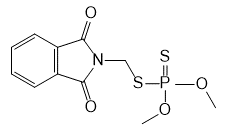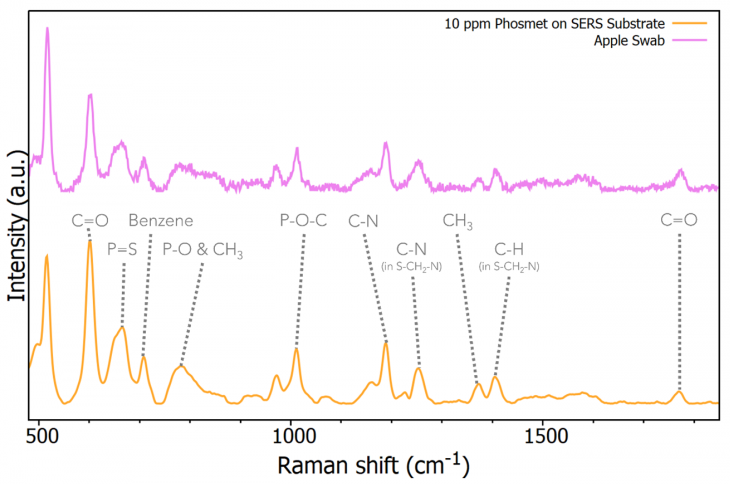As far as the world’s food chain is concerned, safeguarding food crops is crucial, and pesticides are a vital tool to repel, kill, and bring pests under control. On a yearly basis, around two million tons of pesticides are utilized worldwide, with this value anticipated to increase over time.1
However, pesticides can result in extreme environmental problems for aquatic systems, wildlife (such as bees), air, and soil. The reported effects of pesticides on human health can vary from short-term, such as skin irritation and headaches, to chronic effects, such as cancer and asthma. There are also concerns regarding the impacts of consuming pesticides in small but repetitive doses in the diet.2–4
One technique employed to decrease the threats of pesticides is restricting the enabled concentration utilized on crops. This is regulated by examining the crop and identifying the level of pesticide present. Apples come under the most pesticide-treated fruits, and producers have a list of regulations they should follow for sale to the public.

Figure 1. Chemical structure of phosmet. Image Credit: Edinburgh Instruments
An organophosphate insecticide called phosmet is applied on apple trees to regulate codling moths. The pesticide residue tolerance for phosmet on apples is set at 10 ppm in the 2018 Code of Federal Regulations. Mass spectrometry, high-performance liquid chromatography, and gas chromatography are commonly used for testing at low concentrations.
These methods are time-consuming and expensive, whereas Raman spectroscopy has many benefits, including non-destructive and rapid fingerprint-like characterization with little to no sample preparation.
To offer the lower limits of detection, an enhancement technique called surface-enhanced Raman scattering (SERS) is used with Raman spectroscopy. SERS provides a signal enhancement of a maximum of 1010–1015 and favorably quenches the fluorescence of analytes.
Commercial SERS substrates are very much accessible, which makes SERS a readily available technique for low-concentration detection. In the current application note, SERS is used to detect residual phosmet insecticide on apple skin.
Materials and Methods
To examine the phosmet samples, an RM5 Raman Microscope fitted with a 785 nm laser and a 600 g/mm grating was utilized. To offer the enhancement impact, Hamamatsu’s Gold SERS substrates were utilized. As gold nanoparticles tend to absorb from 520 nm to 580 nm, the favored excitation wavelength for gold SERS substrates is standardly 785 nm.

Figure 2. Experimental workflow for apple skin analysis. Image Credit: Edinburgh Instruments
Aqueous solutions of 10 ppm and 1 ppm phosmet were made. Then, 6 µL of every phosmet solution was pipetted into the SERS substrate’s well, left to dry, and examined. A small volume of 10 ppm phosmet solution was dropped onto a cleaned and cut-out section of apple skin and left to dry to make a contaminated apple sample.
After drying, a wet cotton bud was utilized to swab the apple skin surface and positioned into a small volume of water. Onto the SERS substrate, 6 µL of this sample was pipetted for examination.
By placing under the Raman microscope and exciting the sample with a 785 nm laser, the SERS substrates were examined using five seconds of exposure time. Since no spatial resolution was needed, the pinhole diameter was set at 2 mm to increase the Raman signal.
Results and Discussion
The Raman spectra of the four samples examined are shown in Figure 3. The 10 ppm solution was analyzed in a cuvette, implying no SERS enhancement; this measurement was carried out to show the standard Raman response from phosmet at a low concentration.

Figure 3. Raman spectra from three phosmet solutions and a spiked apple skin swab. Image Credit: Edinburgh Instruments
With no enhancement from the SERS substrate, the 10 ppm solution of phosmet has very little Raman signal. However, a strong Raman spectrum was noted when deposited on the gold SERS substrate. Upon further dilution to 1 ppm, a pronounced Raman signal is still achieved showing the low detection limit that is likely with SERS.
The spectrum displayed in pink in Figure 3 is the swabbed apple skin that has been spiked with 10 ppm phosmet. The spectrum is noisier compared to the 10 ppm solution of phosmet. But well-defined peaks are still noted, peak assignments are elaborated in Figure 4.

Figure 4. Raman spectrum from 10 ppm phosmet solution and spiked apple skin swab. Image Credit: Edinburgh Instruments
Band assignments in Figure 4 stress how sensitive the fingerprint region of a Raman spectrum is to specific functional groups enabling pesticide identification.5
The majority of the peaks noted in the 10 ppm solution spectrum are easily visible in the apple swab spectrum. Generally, while the peaks are less intense and noisier, the Raman spectrum is simply recognizable as phosmet following smoothing and normalization.
Conclusion
This study showed a non-destructive sampling and analysis method for tracking low concentrations of pesticides on apple skin. Gold SERS substrates were utilized to improve the Raman spectrum of a phosmet. This proves efficient at determining concentrations at the residual tolerance level that has been set by the Code of Federal Regulations.
References
- Sharma, A. et al. (2019) Worldwide pesticide usage and its impacts on ecosystem. SN Applied Sciences. 1.
- Kim, K.-H., Kabir, E. & Jahan, S. A. (2017) Exposure to pesticides and the associated human health effects. Science of the Total Environment.
- Bonner, M. R. & Alavanja, M. C. R. (2017) Pesticides, human health, and food security. Food and Energy Security. 6, pp. 89–93.
- Rani, L. et al. (2021) An extensive review on the consequences of chemical pesticides on human health and environment. Journal of Cleaner Production. 283, p. 124657
- Jiang, L. et al. (2019) Rapid detection of pesticide residues in fruits by surface-enhanced Raman scattering based on modified QuEChERS pretreatment method with portable Raman instrument. SN Applied Sciences.

This information has been sourced, reviewed and adapted from materials provided by Edinburgh Instruments.
For more information on this source, please visit Edinburgh Instruments.